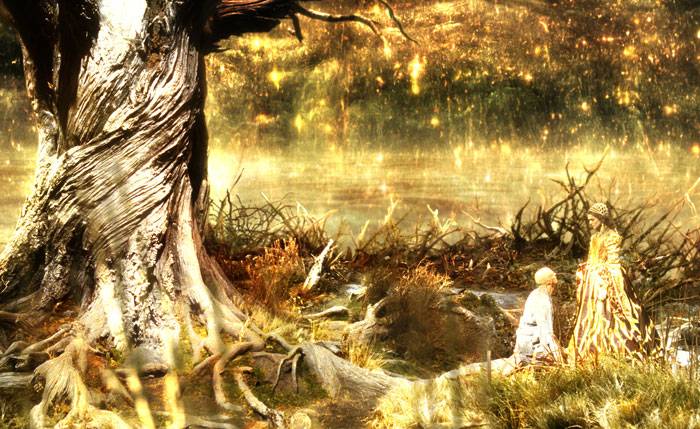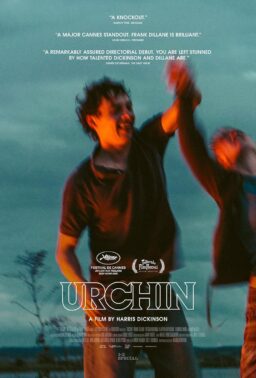Guest commentary by Matt Withers, Brunswick, MD
After watching Darren Aronofsky‘s beautiful “The Fountain” the other evening I was struck by what an amazing tale it told. A quick Google search later led me to believe that so far no one has given it credit as a story that makes much sense; I found simply a mass of possible interpretations. I actually believe there is a very clear and linear story being told (albeit in a Pulp Fiction-y kind of timeline). Since I have not come across any explanation similar to my own, I thought I would share it — film fan to film fan.
To begin our exploration of just what the hell is going on in “The Fountain,” our first task is to determine which, if any, of the three story lines presented is real. We know that the story of Tomas the Conquistador is a fiction. The book “The Fountain”, written in the present day by Izzy, tells Tomas’ journey. Since we see no evidence in the film of her possessing some sort of psychic-historical link, nor any mention of Tomas or even Spain in the research Izzy explores for her book, we can safely determine that Tomas’ story is just that – a story. Specifically and importantly, Izzy has written all but the final chapter when she dies.
Given that Tomas is a fictional character in the universe of the film, we must now turn our attention to both present day Tom (Tom 1), and Spaceman Tom (Tom 2). It is made clear that both these men are in some fashion the same man. While the evidence could take up pages to list, it is enough to recognize that they have the same name, the same tattoo of a wedding band on their ring finger, and the same memories of Izzy. While it may seem tricky to establish if Tom 2 is actually Tom 1, somehow still alive 500 years in the future, or some other fiction, fear not for the answer is actually quite simple.
Tom 2’s journey is clearly the final chapter of Izzy’s book, the chapter she asked Tom 1 to finish for her as she lay on her deathbed. In it we find the Spaceman transporting the Tree that seems to contain the spirit of both his beloved Izzy and Queen Isabella to a dying nebula. In Tom 2’s journey lie all the elements we would expect a grieving husband, a man who is a scientist not a writer, to present when finishing a story he did not start. It is his love letter to his dead wife.
What a beautifully romantic literary conceit that Tom 2 transports the Tree to the exact nebula that Izzy described to Tom 1 on their rooftop that winter night – Xibalba. His spaceship is completely constructed around sustaining a perfect representation of the romantic idea that Izzy shared from her Mayan guide — the guide’s belief that his father, after having a tree planted over his grave, became a part of that tree and every living thing it gave sustenance to.
In addition we notice that Tom 2, as mentioned earlier, is haunted not just by memories of Izzy and her present day interactions with Tom 1, but also of Queen Isabella from the Conquistadors story in Izzy’s book. Since we have determined the story of Tomas is a fiction, the memories of Isabella cannot be real. They can only be imagined. It is hard to believe that if Tom 2 is Tom 1still alive in the future, that the treasured memories of a lost wife would have been combined and given equal weight with the imagined interaction with a fictional queen. So if we accept that Tom 2’s memories are only partially real, that lends credence to the recognition that he is not a real man, but a fictional amalgam created by Tom 1. One with the memories of both Izzy and the book that was her dying work.
Even if we do accept the premise that Tom 2 is the same man as Tom 1, we have the complication that Tom 2 physically appears in the ending of Tomas’ story, in fact being the sole reason that Tomas is granted entrance to the site of the Tree of Life. Are we to believe that a real man somehow became a physical part of a fictional story? To me this strains credulity within the universe of the film, especially when a simple answer exists. Notably our original answer which to reiterate is this – Tom 2’s journey is the last chapter of “The Fountain,” written by Tom 1 at his wife’s request.
Some of the notable evidence to further this argument is: The final chapter has a completely different tone than Tomas’ tale, which we would expect since a different writer finished the book. It features a far more metaphysical approach; to be expected by a scientist finishing the work of a romantic. And most importantly it keeps Izzy’s memory, and Tom 1’s dedication to it alive, by transporting him to a future where there is still a chance to save his beloved. Even small details like the hairs on the tree mimicking the hairs on Izzy’s neck when Tom 1 whispered to her in her sleep scream of the somewhat overly sentimental writings of a non-author scientist trying to finish his wife’s book.
Equally compelling is the fact that Tom 1’s journey does not end in the movie. Both Tomas and Tom 2 find a spectacularly interwoven denouement, while Tom 1 simply plants a seed above his wife’s grave, and presumably, his life goes on.
So our two fictions explode together in a cosmically romantic ideal concerning death and the love it continues to nourish, while our protagonist searches for meaning in a world without his wife.
Is all of this easy to arrive at? Perhaps not, but it all makes for a beautifully fulfilling story that only grows richer with time. Certainly Aronofsky could have given this understanding to us if he so wished. A simple scene of Tom 1 beginning to write the future tale would have answered all questions and removed any need for deeper study.
But it was genius to leave it out. Because without that scene the movie requires a focused study of the themes, characters, and events to arrive at a solution. Given the weight of what he took on, Aronofsky ensured that anyone struck by the beauty of the film would have to continue to mull over what it felt about love, death, loyalty, rebirth and our place in the universe.
Instead of giving us easy answers, Aronofsky gave us all an opportunity to explore that which is deepest and most sacred in ourselves and those we love. The fact that he happily risked the derision of critics put off by the films audacious scope, or simply too lazy to contemplate a work that was more challenging than typical RomCom fare, shows that among many other admirable qualities, Darren Aronofsky is a filmmaker with gigantic, bubble-spaceship-sized balls.
Matt Withers describes himself: “I’m a stay at home dad/writer/budding poker player. I do interviews, columns and the occasional set visit for JoBlo Media. My ‘Fountain’ essay is a personal work, however. I’m 34 years old, lifelong film fan. Have nearly sold 3 screenplays, but in that ‘Horseshoes’ and ‘Handgrenades’ kinda way.”
Read a response to this theory of the film here.
Got your own take on “The Fountain”? Join the discussion here:
http://tinyurl.com/2pcdy9












